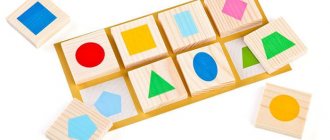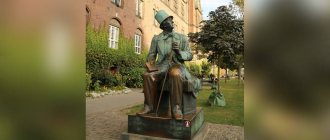At what age is a child ready to understand time?
Obviously, it is best for a child to understand how to tell time by a clock before he goes to school. It’s good if the baby himself shows interest in this topic, asking his mother questions: “Is 10 minutes a very long time?”, “How soon will we go for a walk,” etc.
It’s great if the child himself shows interest in the topic of time, the structure of clocks, and asks his parents relevant questions
Before starting training, parents should give the child a general understanding of time (how it moves, what the past, present and future are, the time of day).
This is usually explained to preschoolers in kindergarten. However, not all children attend preschool or do so irregularly.
In addition, in order to understand how the clock works, the child must be able to count to 60 and know how the indicated numbers are written. It will also be great to understand counting with fives and tens (this is not necessary, but will be just perfect).
Therefore, the specific age at which you need to start learning to tell time using a clock cannot be stated unambiguously (each child is individual, as well as the pace of his development). Some people are ready for this as early as 5 years old, others only at 7 years old.
How to explain to a child what time is
If you ask an adult: “What is time?”, he may answer that it is a certain parameter, or a certain interval between events, or he will express some other philosophical reflection.
Have you ever wondered how a child will answer this question? What is the concept of “time” for him? Do a simple experiment and ask your children. The answers may be very interesting.
To gradually give your child an idea of time, it is necessary to form the following concepts:
- Times of Day;
- season;
- units of time;
- passage of time (fast, long, often, rarely, yesterday, today, tomorrow).
These concepts are given to preschoolers by parents and kindergarten teachers. To do this, they can use the following techniques: conversations, stories, games, poems, riddles. Before explaining clock time to a child, it is important to prepare him for the perception of time in a broader sense.
Seasons
At 3 years old, a preschooler begins to associate weather with seasons. At first, these are primary and pronounced signs: in summer it’s hot, in winter it’s cold.
With growing up, the amount of information gradually increases, and by the age of 7, the child knows the number and order of seasons, the number of months in a year, the order of months, and the classification of months by season.
Children receive all this information by watching the weather, looking at illustrations, memorizing poems, and listening to riddles. For better memory fixation, each month is associated with a natural phenomenon, human activity, or some holiday.
For example: Mom explains to the baby: “Winter has come. Look, it's snowing outside. Let's put on a fur coat, hat and boots. Cold. Children are making a snowman. New Year is coming, we will decorate the Christmas tree, and Santa Claus will bring gifts.”
Particular attention is paid to the calendar. With its help, the child will be able to clearly understand long periods of time: day, week, month, year.
Four times of day
Children begin to learn simple concepts of “day and night” before the age of 3 years. Later they begin to understand the meaning of “morning - evening”. To formulate these concepts, it is recommended to use pictures with the actions of animals or people at different times of the day, didactic games (“When does this happen?”), riddles, and nursery rhymes.
For example, guess the riddle: “The children went for a walk, they are observing. The sun is shining brightly in the sky, the birds are singing happily. (Day)
Note: In order for the child to correctly form concepts about the time of day, before napping you should not automatically say “Good night”, you should wish “Good sleep”.
Hourly intervals
At the age of 5 - 7 years, you can teach children to understand time by clock. How to determine the exact age point?
If a preschooler himself begins to show interest in watches, asks to explain what the watch shows, where the hands are, when his favorite cartoon starts, what time dad will return from work, then your child is ready to learn complex information about hour intervals.
And in order for this information to contribute to the perception of time, and not a superficial understanding of the “numbers” on the clock, the preliminary preparation described above is precisely important.
Productive and easy techniques for learning how to make a clock
It is advisable to again divide learning to tell time using a clock into separate lessons.
Memorizing and understanding numbers
Many older preschoolers can already count well, some children even up to a hundred. However, in this case it is important to remember the numbers that are multiples of five (5, 10, 15, 20, etc. up to 60).
Even if your baby can count well, it is important that he identifies numbers that are multiples of five.
We can explain that we are interested in numbers that end in 0 and 5.
Getting to know the dial and hands
It is easier to introduce a child to the dial on a toy watch. They can be flat or more voluminous. The main thing is that the numbers are clearly visible and the arrows rotate easily.
It is better to teach your child not on a real watch, but on a toy one, where the numbers are clearly visible and the hands rotate easily.
You can make such a thing yourself from ordinary cardboard or a disposable plate.
You can make a training clock yourself
You need to tell your child that the surface of the watch is called the dial. It can be compared to a pie or an orange: it can be mentally divided into pieces or slices. There are two hands on the dial: a shorter one (it shows the hours) and a longer one (it shows the minutes).
It is necessary to briefly mention the second hand and tell you that it is not found on all watches. This is an arrow that moves very quickly, because a second is a very short unit of time, it is literally one moment.
Next, the adult explains that although there are 24 hours in a day, only 12 digits are reflected on the dial. The thing is that during the day the hour hand (short) goes around the circle twice.
We learn to determine the clock on a simulator with a small hand
First, you should focus the child’s attention on the movement of the hour hand (we don’t touch the minute hand yet). For example, we put the short hand on o and explain to the baby that the clock shows 2 o’clock (if the design of a toy clock allows, the minute hand can be removed for now).
Then the preschooler is asked to set the time himself, which the adult will tell him.
First, let your baby learn to tell the exact time (hours only, no minutes)
Let's move on to minutes
Then the minute hand joins the teaching. First, it is best to explain to a preschooler the concept of “half an hour” - when the long hand is on o (at the same time “30”). You can compare it to half the pie.
After this, we move on to the concept of “15 minutes” (the number “3” on the dial, or a quarter of the pie).
At first it’s easier to show what half an hour and 15 minutes are
After this, we move on to the remaining minute intervals - we show the child all the possible options and invite him to independently set one or another according to the instructions of the adult.
Let the preschooler show a variety of time intervals in minutes on the clock
It may be a little difficult at first, but repeated repetitions will do the trick. In addition, to make it easier to count large intervals, you can first divide them into two parts: 30 minutes and 10 minutes - this turns out to be 40 minutes.
Then you should tell the child that the minute hand can stand not only on a mark that is a multiple of five, but also on other divisions (for example, it can show 6, 14, 27 minutes, etc. You need to draw the child’s attention to the fact that these divisions most often are not signed, but simply marked with short segments or dots to avoid cluttering the dial.
Please note that the arrow may not always point to a multiple of five.
It's also worth noting that adults sometimes round up time. For example, if the minute hand shows 29 minutes, then they often say “it’s 30 minutes now,” etc.
We combine hours and minutes and teach how to tell the time on a watch
When the baby learns to separately show the given hours and minutes on the dial, you can combine these units. Again, first the adult shows various examples, for example, 2 hours 15 minutes. Then the preschooler starts training.
There is one caveat here. The child must learn that when the minute hand moves, the hour hand moves a little. For example, if the time is 5 hours 30 minutes, then the hour hand will not be on o, o in the middle between “5” and “6” (After all, it is not exactly 5 o’clock, but a certain time has passed).
The child must understand that when the minute hand moves, the hour hand also moves slowly.
How to clearly explain “day” and “night” time
And the last stage of teaching is to explain to the child that there is “night” and “day” time (we already told him earlier that there are 24 hours in a day, and the hour hand goes around the dial twice during this time).
The best way to deal with this complexity is to use a special simulator that you can easily make with your own hands:
- You need to cut out two cardboard circles of the same size, but different colors. The first one will be “daytime”, numbers from 1 to 12 are written on it. The second one, accordingly, will be “nighttime” (numbers from 13 to 24). Small cuts are made on the first dial so that the number can be slightly bent. Arrows are also made.
You need to cut out two dials of different colors and sign different numbers on them
- The dials are fastened together (they are fixed by arrows). At the top is the “day” part. Then we show the child, for example, 4 o’clock in the morning and show which “night” number corresponds to this (it will be 16 o’clock).
First, the adult shows the “day” hour, and then, bending the window, demonstrates the “night” hour.
It should be understood that the division into “night” and “day” time is quite arbitrary. After all, 2 hours is, in fact, night, not day, and 15 hours is day, not night. The child just needs to understand that when we say, for example, 19 o’clock, then it is evening, but the hour hand will point to the number 7, etc. Įtempiamos lubos Visoje Lietuvoje Gera kaina Vilnius Jonava Montavimas maybe on the specified simulator.
The simulator will help the child remember which “night” numbers correspond to “day” ones.
Introducing children to watches
Content.
Introduction………………………………………………………………………………..3
Tasks and content for familiarizing older preschoolers with clocks……….…4
Stages of work to familiarize older preschool age with clocks……..…7
Methodology for introducing children to watches…………………………………………………………10
Practical task: Compiling a mathematical fairy tale to familiarize children with watches as a time measuring device……………………………………………………………12
Conclusion………………………………………………………………………………13
References……………………………………………………………..……14
Introduction.
It is vital for preschool children to learn to navigate time themselves: to determine, measure time, correctly denoting it in speech, to feel its duration in order to regulate and plan activities in time, to change the pace and rhythm of their actions depending on the availability of time. The ability to regulate and plan activities over time creates the basis for the development of such personality qualities as organization, composure, focus, precision, which are necessary for a child when studying at school and in everyday life.
The specific features of time as an objective reality make it difficult for children to perceive it. Therefore, in pedagogical practice the question arises of how to show the time to a child. Time is perceived by the child indirectly, through the concretization of temporary units and relationships in constantly recurring phenomena of life and activity.
At preschool age, children do not yet correlate temporal sensations with the objective passage of time, however, there is a constant process of accumulating knowledge about objects and phenomena of the surrounding world, organized in time (seasons of the year, mastering concepts such as “today,” “tomorrow,” “yesterday” , “first”, “then”, etc.). This is facilitated by the development of speech, thinking, and awareness of one’s own life.
The purpose of the work is to study the features of the development of temporal representations in children of senior preschool age.
Achieving the goal will be facilitated by solving the following tasks:
— study theoretical approaches and methodological recommendations for introducing older preschoolers to time;
— study scientific and methodological literature on the perception of time by preschool children.
1. Tasks and content for familiarizing older preschoolers with clocks.
At the same time, the specific features of time as an objective reality make it difficult for children to perceive it. Time is always in motion, the flow of time always occurs in one direction - from the past to the future, it is irreversible, it cannot be delayed, returned and “showed”. Therefore, even older preschoolers sometimes doubt the existence of time and ask: “If there is time, show it to me.”
Therefore, teachers of preschool institutions are faced with the problem of familiarizing children with time - an intangible phenomenon in the condition of the predominance of visual-figurative thinking and perception of preschool children.
Diagnosis of the development of time concepts in older preschoolers should include tasks to determine the child’s knowledge of the names of the parts of the day; the child’s knowledge of the names of the days of the week, their sequence and the ability to determine what day was yesterday, today, and tomorrow; the child's knowledge of the names and sequence of months, seasons and which months make up which seasons; the child’s ability to tell time using a calendar, hourglass and mechanical clock; the ability to determine time by the cyclicity of natural phenomena.
It follows from this that, in accordance with the diagnostic tasks, its structure will consist of five blocks of tasks: a study of the child’s knowledge of the names of the parts of the day, the ability to determine them by the cyclicity of natural phenomena and human activity; identifying the child’s knowledge of the days of the week, their sequence and the ability to determine what day was yesterday, today, and tomorrow; determining whether the child knows the names of the months and seasons, their sequence and which months are included in a certain season; identifying the ability to determine time using a calendar and mechanical watches. Based on the characteristics of the perception of time by preschool children, it is possible to specifically determine through which objective phenomenon one or another temporal mathematical concept can be formed (see Figure 1).
Figure 1. Formation of mathematical concepts through objective phenomena.
The main tasks for developing temporary representations are:
— formation of primary practical orientation in time;
- formation of a sense of time;
— familiarization with individual “temporary” standards;
— formation of initial ideas and concepts about some properties of time (objectivity, periodicity, simultaneity).
Based on psychological and pedagogical research, means are identified that provide children with time orientation training: the accumulation of social experience in various types of activities, artistic means, social and natural phenomena of the surrounding reality, various models - as material and materialized forms of visibility.
A simplified and adapted to the psychological characteristics and level of knowledge of preschool children, the definition of the concept “time” is what determines the change of natural phenomena, various events and the duration of the existence of something in us and around us” becomes the result of the material:
1. Time units: basic (day, week, month, year), derivatives (hour, minute, second). Children's acquaintance with units of time measurement should be carried out in a system of strict consistency, where knowledge of some time intervals, the ability to define and measure them, would serve as the basis for familiarization with subsequent ones and would reveal to children the essential characteristics of time: fluidity, continuity and irreversibility.
2. Instruments for measuring time: watches (hourglass, mechanical, electronic).
3. Periodic, including seasonal natural phenomena and periodic (routine) events of everyday life. Calendar.
4. Properties of time.
To measure time, regularly repeating phenomena are accepted: the change of day and night, the change of lunar phases, the change of season, caused by the daily rotation of the globe around its axis, the movement of the Moon around the Earth, and the movement of the Earth around the Sun.
Deepening, clarifying and consolidating the correct understanding and use of tense terms is carried out in classes using handout didactic material.
- Stages of work to familiarize children of senior preschool age with clocks.
The process of forming time concepts in preschoolers in class begins with familiarization with the parts of the day. It is advisable to start such an activity by asking a riddle, using a literary word and a surprise moment. Next, the teacher reveals to the children the meaning of the concept “morning” with the help of a literary word or theatricalization and asks them to choose a color to represent this concept. Then he asks the question: “Guys, how do you know that it’s morning?” Children offer their own guidelines. The teacher proposes to systematize knowledge by creating the “Morning” model. To create a model, a circle of a color representing morning (for example, yellow) is placed in the center of the flannelgraph, and around it are symbols representing a person, the sun, a mechanical clock and a shadow.
On the board there is a mathematical board, in each pocket of which there are cards-symbols indicating different types of human activity, the position of the sun, clock hands, shadows (it is advisable to introduce these symbols before class). The teacher invites the children to select those cards that fit the concept of morning. Each choice is discussed. Then the children independently derive the morning formula, choosing the most characteristic features (Figure 2). And they answer the question: “What is morning?
The concepts “day”, “evening”, “night” are also derived.
2. The next stage is to consolidate the acquired knowledge in various types of activities using a variety of means and teaching methods.
At this stage, you can play the game “When it happens,” use riddles, dramatizations, looking at reproductions of paintings, reading works of art, listening to music. For example, a child is selected, he draws a phantom with the color of some part of the day (for example, a day), but does not show it to the others. With the help of facial expressions and gestures, he depicts one or several signs of the day, and the rest must guess what activity he depicts and what part of the day this activity relates to. Or children are offered a reproduction of a painting (for example, the painting by A.I. Kuindzhi “Dnieper in the Morning”) and they need to give it a name, determining which part of the day is depicted on it. The child who guesses explains by what signs he determined that it was morning (pinkish sky, fog, silence, damp grass, etc.). Work is also carried out with excerpts from works of art and music. The teacher reads the passage and asks you to answer whether the described event occurred in the morning, afternoon, evening or night. If the melody has been dried, the event is established by analyzing the expressive means of the musical work.
3. The next stage is for children to learn about the significance of this or that part of the day for humans and nature. At night, people and nature rest, gain strength, and some animals, on the contrary, wake up and go hunting (for example, crabs) so as not to be noticed, etc.
4. The goal of the final stage of the lesson is to show the time sequence and move on to the new concept of “day”. Children are asked to lay out colored circles in the sequence in which morning, afternoon, evening, night follow. Then the teacher says that morning, day, evening, night form a day, which the children will become familiar with in the next lesson.
In total, it is necessary to conduct seven lessons: to familiarize yourself with the parts of the day, days of the week, months, four seasons and the concept of “year”.
In the process of introducing children to time, you can add activities to form ideas about time and its measurement. Their peculiarity is that a single storyline runs through the entire complex. The children go to the land of Time, where four princesses, Morning, Day, Evening and Night, live in a magical castle. The model of the castle God is a kind of model. It consists of twelve towers, symbolizing the twelve months of the year. Each tower is built in four floors (weeks), each floor is made of seven bricks in the colors of the rainbow (days of the week). The towers differ only in their tops: three towers are white (winter months), three are green (spring months), the next three are red (summer months), and the last three are yellow (autumn months). Thus, during classes, children first get acquainted with the princesses (the times of day), then begin to help them build a castle: they make bricks and lay them out in a certain sequence (they study the concept of a day and days of the week), build floors (they get the idea that four weeks make a month), first they build towers with white domes (they study the winter months), then with green, red, yellow ones. The final lesson can be held in the form of a housewarming party.
All classes are held throughout the year and there are quite large intervals between them, so it is important to continue to familiarize children with time sequence and its measurement in everyday life.
In addition to the above activities, it is necessary to introduce children to clocks and develop a sense of time; for this purpose, games and exercises can be used, which are included in the third part of traditional classes on mathematical development.
The formation of ideas about time should occur not only in specially organized forms, but also in ecology classes, drawing, on walks, in games, and independent cognitive activities.
To strengthen the skills of distinguishing parts of the day based on characteristic activities, you can also use a computer when working with children. The display screen can display prepared image fragments in the color of characteristic objective data: the position of the sun, the presence of the moon, stars in the sky and the corresponding color illumination of the earth's surface; or activities characteristic of each part of the day. Having recognized a part of the day, the child must press the corresponding function key to indicate the identified time with a color symbol. The correctness of the child’s action can be assessed on the display screen in the idea of different reactions of the depicted symbol: for example, a funny person, happy or sad.
- Methods for introducing children to watches.
Starting from the fourth year of life, the formation of temporary representations is carried out in mathematics classes. The main methods and techniques for this are: observations, conversations, explanations, demonstrations, literary expression, exercises, training, didactic games, etc.
The use of these methods largely depends on the age of the children and the characteristics of the specific problems solved in this lesson.
In the senior group, work begins with clarifying the concepts that were formed in the previous group. Particular attention is paid to learning to distinguish between parts of the day, observing not only the work of people, but also the position of the sun. Through observations and comparisons, children are explained the concepts of “vault of heaven,” “sunset,” “horizon,” and are given the opportunity to make sure that the sun moves across the vault of heaven throughout the day. During the day, compared to morning and evening, the sun rises above the horizon, and shadows from objects become short. The period of the day when the sun is high in the sky and children are playing in the garden is called “noon”, this is the middle of the day. Based on direct observations and examination of corresponding reproductions of paintings, children of this age group are introduced to the phenomena: “sunset”, “sunrise”, “twilight”, “dawn” and explain why they say about these periods of the day: “dusk”, “dawn” "
Explaining the essence of time
By the age of three, children, as a rule, know what morning, afternoon, evening are, and how they differ. To teach this, you can use visual aids: cards, pictures, cubes, books. Tell your child when the sun rises, when it sets, and what we do at certain times of the day. For example, in the morning we wake up, wash our face, brush our teeth, and have breakfast. At lunch we eat soup and go to bed for the day.
In the evening it gets dark, the whole family has dinner, then the baby bathes, listens to a fairy tale, and goes to bed. As you know, children perceive new information better during play. Let your favorite toys (dolls, bears, bunnies) wake up, have breakfast, go for a walk, and go to bed. At the same time, talk about what time of day it is for the toys, explain why right now they should go to bed or wake up.
Interesting : We warn correctly about the punishment. Useful methods and advice from psychologists
Making watches with your own hands
A homemade watch will help teach your child how to tell time using a clock. How to make a watch:
- Cut out a circle from cardboard;
- We draw it into four equal parts;
- We divide the quarters into three parts;
- We write numbers on the dial from 1 to 12;
- Cut out arrows from cardboard;
- We attach the arrows using a button, a small nail or a bolt.
It's even easier to make a clock mockup using disposable paper or plastic plates.
It is very good if your child is your assistant. For him, this is additional motivation to learn new things.








